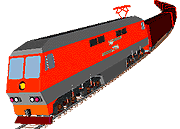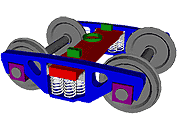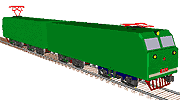UM Loco
UM Loco
The Module for Simulation of Railway Vehicle Dynamics (UM Loco) - UM allows the user - In addition to the standard configuration UM includes - Software verification - UM Loco users
UM Loco users - Vehicle models - Locomotive library - Freight wagon - Tools
Module for Simulation of Railway Vehicle Dynamics (UM Loco)
The program package includes module UM Loco, which is intended for simulation of dynamics of railway vehicles of different types (diesel and electric locomotives, passenger and freight wagons) in both straight and curve railroad tracks. The simulation is performed in time domain by means of numeric integration of differential or differential-algebraic equations of motion. UM Loco allows the user to create fully parameterized models of vehicles. Geometrical, inertia and force parameters may be specified using identifiers. The parameterization of a model is the base for effective analysis and optimization its dynamical behavior.
In some cases to obtain more accurate solution and/or perform a fatigue analysis it needs to introduce in the model of the vehicle flexible bodies imported from ANSYS or NASTRAN instead rigid ones. It could be done with the help of the UM FEM module.
The paper "Simulation of dynamics of railway vehicles in Universal Mechanism software" (8 pages) is an overview of accumulated experience of using Universal Mechanism (UM) software in railway industry. The list of UM users, applied researches and the Universal Mechanism key features are discussed.
Adequacy of the mathematical models of UM was proved with the help of Manchester Benchmarks, click here for details.
UM allows the user
- to calculate the critical speed;
- to analyze 3D dynamics of a vehicle or a train in time domain on straight track or curves with/without irregularities;
- to analyze vehicle dynamics depending on wheel and rail profiles;
- to create multivariant projects for scanning the vehicle/train dynamics depending on any parameters;
- to compute natural frequencies and modes as well as root locus;
- to create hybrid rigid-elastic models of vehicles;
- to perform a durability analysis of parts of vehicles.


UM Loco features
- wheelset as a standard subsystem;
- automatic calculation of rail/wheel contact forces according to various models of creep forces (Mueller model, FastSim algorithm, modified Kik-Piotrowski method, etc.), multipoint non-Hertzian (non-elliptical) contact is implemented;
- specialized graphical interface for animation of contact forces and contact areas;
- interface for creation of rail and wheel profiles and track irregularities;
- interface for setting curve parameters;
- standard list of variables, which characterize rail/wheel interaction (creepage, creep forces, angle of attack, wear factors, etc., more than 30 performances for each wheel).


Software verification
Manchester Benchmarks by The Rail Technology Unit of Manchester Metropolitan University is now de-facto standard for verification of software for simulation of railway vehicle dynamics.
“The aim of producing these benchmarks was to allow railway vehicle suspension designers and researchers investigating vehicle dynamic behaviour to assess the suitability of the various software packages that now exist for simulation of such behaviour.”
So called Manchester Benchmarks were published in 1998 and includes prototypes of passenger and freight cars. Results of simulation of test cars from Manchester Benchmarks are now available for most of commercial software and published in [1]. Results of Manchester Benchmarks for Universal Mechanism software are available in10_UM_Loco_Manchester_benchmarks.pdf (1 Mb).
A number of field and test bench experiments were fulfilled by independent researchers. Sakalo and Kossov in [2, 3] considered dynamics of a TE116 locomotive and drew a conclusion that “… satisfactory convergence of theoretical and experimental values of all considered features are achieved. Divergence between results of computer simulation in UM and field experiments does not exceed 15 %.” Pavlukov and others ran test bench experiments with a freight three-piece bogie. Convergence between results of numerical simulation and test bench experiments within 10% bounds is obtained, [4].
References
1. Iwnicki, Simon D. The Manchester benchmarks for rail vehicle simulation / ed. by S. Iwnicki. - Lisse: Swets & Zeitlinger, 1999. Available on Amazon2. Kossov, V. S. Reducing dynamical loading of running gears of locomotives and railway track. Doctoral thesis, Kolomna, 2001 (in Russian)
3. Sakalo V.I., Kossov V.S. Contact problems of railway transport. Moscow: Mashinostroenie, 2004. (in Russian)
4. Pogorelov D.Yu., Pavlukov A.E., Yudakova T.A., Kotov S.V. Simulation of contact interactions in multibody system dynamics. / Dynamics, strength and reliability of transport machines / ed. by V.I. Sakalo. Bryansk: Bryansk State Technical University, 2001. P. 11–23. (in Russian)
Universal Mechanism software is used by the following design institutes, factories and colleges from railway industry:
Bryansk Machine Building Plant JSC, Bryansk
ZAO CNII TransElectroPribor JSC, Saint Petersburg
Central design office of transport engineering, Tver
Kolomna Locomotive Works JSC, Kolomna
Metrowagonmash JSC, Mytischy
Railcar-Building Engineering Centre the group of companies, Saint Petersburg
Russian Railways
State Unitary Enterprise "Production Association "URALVAGONZAVOD" , Nizhniy Tagil
Transolutions CIS, MoscowUnited Wagon Company LTD, Moscow
Ural Locomotives, Limited Liability Company, Verkhnyaya Pyshma, Sverdlovsk Region
Ural State University of Railway Transport, Ekaterinburg
All-Russian Design Institute of Electric Locomotives JSC, Novocherkassk
All-Russian Locomotive Design Institute, Kolomna
All-Russian Railway Design Institute, Moscow
Tver Car Works, Tver
RailTransHolding, Moscow
Bryansk State Technical University, Bryansk
Far-Eastern State University of Railway Transport, Khabarovsk
Irkutsk State University of Railway Transport, Irkutsk
Moscow State University of Railway Transport, Moscow
Omsk State Transport University, Omsk
Petersburg State Transport University, Saint Petersburg
Rostov State University of Railway Transport, Rostov-on-Don
Russian State Open University of Railway Transport, Moscow
Samara State Academy of Railway Transport, Samara
South Russian State Technical University (Novocherkassk Polytechnic Institute), Novocherkassk
Slovakia
ASTRA Rail Project s.r.o.
Turkey
State Railways of the Turkish Republic (TCDD)
TUBITAK Marmara Research Center
Ukrane
Dnipropetrovsk State Technical University of Railway Transport (DIIT), Dnepropetrovsk
National Mining University, Dnepropetrovsk
State Research and Design Center of Railway Transport, Kiev
Australia
WorleyParsons Limited,
Institute of Railway Technology, Monash University, Melbourne
Belarus
Belarusian State University of Transport, Gomel
Belarusian Autoworks, BELAZ, Minsk
China
Chinese Academy of Railway Sciences (CARS)
CRRC Qingdao Sifang Rolling Stock Research Institute Co., Ltd
East China Jiaotong University
Southwest Jiaotong University
Shijiazhuang Tiedao University
Beijng Jiaotong University
CRRC Nanjing Puzhen Co., Ltd.
Southwest Jiaotong Univeirsity Emei Campus
CRRC Zhuzhou Times New Material Technology Co.
Indonesia
INKA, Indonesian Railway Industry
KNKT (The National Transportation Safety Committee)
Korea
Seoul National University, Seoul
Korea National Railroad College, Uiwang
Hongik University, Seoul
Korean Rail Research Institute
Lithuania
Vilnius Gediminas Technical University, Vilnius
Poland
Silesian Technical University, Katowice
High School of Economics and Innovation, Lublin
Kazimierz Pulaski University of Technology and Humanities, Radom
Poznan University of Technology, Poznan
Poznan Industrial Institute of Agricultural Engineering, Poznan
USA
Amsted Rail Inc., Delaware
UK
Newcastle University, Newcastle
Vossloh Espana S.A., Valencia




